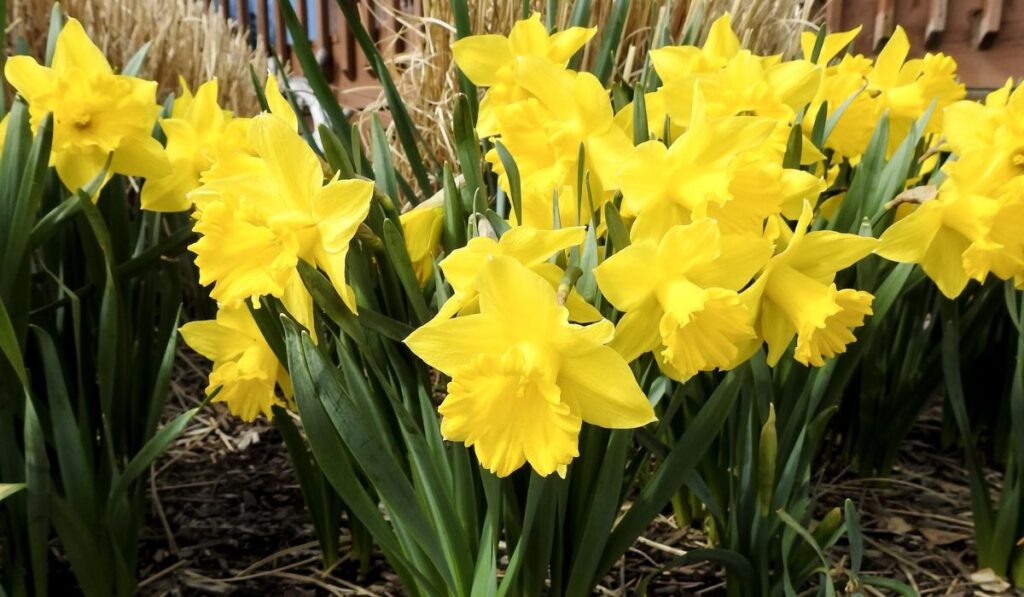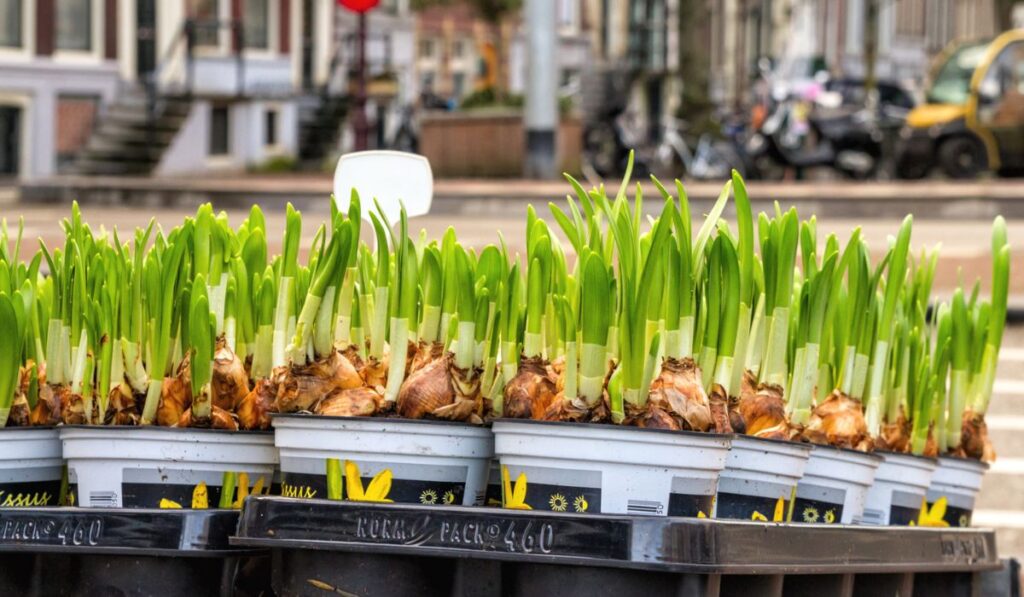Are you looking for techniques to plant daffodils in your garden? If yes, you are in the right place. Planting daffodils at the right time is crucial if you want to see them bloom perfectly.
Plant daffodils in fall after warm temperatures subside. The best months for planting daffodils are late September to early October. They should be sprouted in a pot, in a cool place, and then moved to sunlight before planting. Water them whenever the soil is dry.
To choose the right daffodil variety, you must know their details. Moreover, pest and disease control is essential for the successful growth of daffodils. So, read further if you want to know when and how to plant, grow, and maintain daffodils and keep them away from insects, pests, and viruses!
When to Plant Daffodil Bulbs?

Daffodils are such cheery flowers that they can rejuvenate the sight of your garden like no other plant. But, first, you must know when to plant daffodils to grow them perfectly.
They bloom in early springs, and as soon as spring starts, you can see beautiful daffodils fully grown in your garden. The best time to grow daffodils is in the fall. You can sow them in September-November before winter starts.
It requires cooled-off soil with a well-working ground. Therefore, growing daffodils isn’t suitable during the rainy season or warm temperatures. They do need moisture but with proper drainage.
You can wait until November or early October in warmer climates to grow daffodils. However, if warm temperatures have subsided in your area during September, you can plant daffodil bulbs easily. They require a soil temperature of approximately 60 degrees F.
Daffodils will bloom during spring in the months of February-April. Some can grow in January as well, but it depends upon the variety of daffodils you choose. To make them bloom in late winter before spring starts, you can use different tips and tricks to force daffodil bulbs.
Daffodil Varieties
There are tons of daffodil varieties that you can choose from. All of them have distinguished features and requirements for growth. Some of the most common daffodil varieties are mentioned below!
Trumpet or Long Cup Daffodils
The cups of trumpet daffodils are either as long as the petals or longer than the petals. They have a crown-like structure. They have large flowers with one flower per stem. The yellow trumpet daffodils (Yellow River) are the most common types of daffodils. Other examples include Dutch Master and Goblet.
Double Daffodils
Double daffodils have a bouquet of petals instead of cups in the center. Outer petals have multiple layers and are blended with the lower petals. There can be more than one flower per stem in double daffodils. It can go as tall as 16 inches, such as Golden Ducat and Petit Four.
Most commonly, double daffodils are fragrant. Other examples include La Torche, Tahiti, White Lion, Dalnashaugh, Lingerie, Sherbourne, etc.
Small Cup Daffodils
Small cup daffodils have a cup that is smaller than the petals. They are fragrant and grow a single flower per stem.
Large Cup Daffodils
Large cup daffodils vary in appearance and can be found in totally yellow color, yellow and orange color, yellow and white color, white and orange color, etc. they have both a large cup and large petals with one flower per stem. Some examples include Pink Pride, Orange Progress, Ice Follies, etc.
How to Plant Daffodils?
If you want to know how to plant daffodils, you are in the right place. However, there are certain factors you have to consider and some tips to use while planting daffodils successfully. So, let’s get started!
Select the Right Type
First, you have to choose a good daffodil variety for your garden. The most common ones are Yellow River, Golden Ducat, and Petit Four.
Choose Form or Planting
You can plant daffodils individually, in groups of 3 or 5, or in rows. No matter the form of planting you choose, keep all the daffodils 4-6 inches apart.
Planting Technique
The pointy end of the daffodil should face upward. The bulb should be planted as deep as its height’s double. For example, a bulb 1cm high should be planted 2 cm deep in the soil. Add a little bit of bulb fertilizer to the hole of the daffodil.
Water the Daffodils
After planting the daffodils, water them thoroughly. Then you must water them once every week for the first three weeks. Then, when you see them growing, water them again if there is no rain for 2-3 weeks.
For a small garden, you can get a watering can such as Novelty 30601 Indoor Watering Can (on Amazon).
Growing Daffodils
Growing daffodils from seeds takes years to get to daffodil bulbs. Therefore, this method is only undertaken by professionals. However, most people use daffodil bulbs for growing daffodils.
From Seed
You can take the seed pods when the daffodil flowers fade. Wait for those seed pods to turn brown and extract seeds from inside. Then, plant the seeds in a pot with a seed starter mix. You can use Miracle-Gro Seed Starting Potting Mix (on Amazon).
Let the seeds grow for at least three years in the pot. It will take 5-6 years for daffodil bulbs to be large enough to plant in your garden.
From Bulbs
To grow daffodils from bulbs, use a low-nitrogen, high potassium fertilizer. Choose a pot with drainage holes and a size of about 2 gallons. Place the bulbs in the pot and cover them lightly with compost and water. Keep the pot in a dark spot with a temperature of 40-45 degrees F.
After 12-16 weeks, when the yellow shoots arise, place the pot in a sunny yet cool spot. The temperature can go up to 60 degrees F. Keep watering the plants.
After the shoots turn green, place the pot in sunlight at 60-70 degrees F temperature. Let the plants grow till they die off, and don’t cut them earlier. Then, cut the dead plants from the base to remove them.
When the daffodil flowers fade away, you can add bone meal to prepare the soil for next year’s bloom.
Maintaining Daffodil Plants

Maintaining daffodil plants is vital if you want them to stay longer and cheer up your garden. It doesn’t involve any rocket science. All you need to remember are a few things mentioned below. So, let’s get started!
Water
Daffodils require generous watering during the blooming phase. Whenever the soil feels dry to the touch, you must water it. Water daffodils once every week. In dry areas with no snow, frequent watering will be needed. However, in the dormant phase, keep the soil dry.
Sunlight
Daffodils should get good sunlight. Keep them in 60-70 degrees F temperature and let them sit outside at least 6 hours a day. But a low temperature (35-40 degrees F) is ideal when the plant is setting its roots.
Fertilizer
In the autumn, add potassium-rich and low-nitrogen fertilizer to the soil. Make sure to keep the fertilizer away from plant leaves.
Toxicity
Keep daffodils away from animals, especially dogs, cats, and horses. Daffodils are toxic to animals and can harm them. Even a vase that had daffodils at some point in it should be kept away from animals.
Moreover, freshly cut daffodils are toxic for other plant varieties for up to 24 hours due to the production of milky sap.
Common Pests and Prevention
Many insect varieties prey on daffodils. These include:
- Bulb Fly
- Aphid
- Bulb Mite
- Narcissus Nematode
- Narcissus Basal Rot
- Slugs and Snails
- Viruses
Basal Rot
Basal rot is a daffodil disease that can be prevented by using non-disease bulbs and proper planting and propagation techniques. Pink fungus, stunted growth, and no flowering are some basal rot symptoms.
All these varieties can wither daffodil bulbs, and the plants start rotting. However, you can prevent these insects and viruses from munching on daffodils by following the prevention methods below!
Prevention
Here are some prevention tips:
- You can use frogs, hedgehogs, or parasitic nematodes for slugs and snails. Then, pick them up at night and add them to soapy water.
- For bulb fly, use pyrethrin-based insecticides and get rid of infected bulbs to prevent further infection. Use insect nets and traps to control the fly population.
- Cosmolaelaps caliger preys on bulb mites, so you can introduce them to daffodils to control bulb mites. Use miticide on all daffodil bulbs to prevent infestation.
- Before planting daffodil bulbs, soak them in water and formalin to prevent nematode infestation.
- Place daffodil bulbs deep in the soil to prevent infestation.
- Keep the pot in a windy area, so insects and viruses fly away.
Final Thoughts
By following proper planting techniques and planting daffodils at the right time, you can flourish your garden with this beautiful flower.
Planting daffodils isn’t hard but requires some precautions to keep the pests and diseases away. Otherwise, all the daffodils can be damaged. Daffodils should be planted 2-4 weeks before a winter freeze.
